Why Trust Gadgetbyte?
At Gadgetbyte, we invest substantial hours into rigorously testing each product or service we review, guaranteeing that you make informed purchases. Learn more about our testing process.
Review Overview
Design & Build
10/10
Display
9.5/10
Performance
10/10
Back Cameras
9.5/10
Selfie Camera
9/10
Software & UI
10/10
Battery
8.5/10
Value for Money
9/10
Despite all the hypes, ultimately, the OnePlus 9 Pro is quite similar to its predecessor—and that's not particularly a bad thing. The phone is wickedly fast, the battery juices up quick and it's got a great design. However, the first year of OnePlus' collaboration with Hasselblad doesn't seem to have paid off as the OnePlus 9 Pro still doesn't compare to the reigning flagship smartphone cameras.
It’s been quite some time since OnePlus launched its flagship phone for 2021, the OnePlus 9 Pro. And ever since the launch, it has been surrounded by a lot of criticism. Firstly, for the excessive marketing campaign that OnePlus employed to generate hype for its partnership with Hasselblad. And then there were a series of software bugs, Bluetooth connectivity, and overheating issues, out of which some have been fixed while a couple of them still await their turn. So what should you expect from the forthcoming long-term review of the OnePlus 9 Pro?
I have been using this phone for about a month now – 2 weeks as my secondary device while I was reviewing the Realme 8 Pro, and then it’s stayed in my pocket as my primary phone for about 2 weeks. So I think I am finally ready to share my long-term experience of the OnePlus 9 Pro in this review. Let’s get started!
OnePlus 9 Pro Specifications:
- Body: 73.6 x 163.2 x 8.7mm, 197 gm, Corning Gorilla Glass 5, IP68 dust/water resistant
- Display: 6.7-inches Fluid AMOLED, 1Hz-120Hz Refresh Rate, 360Hz touch sampling rate, 10-bit color depth, 1300 nits, HDR10+, LTPO backplane, Gorilla Glass 5
- Resolution: QHD+ (3216 x 1440 pixels), 20:9 aspect ratio, 525 PPI
- Chipset: Qualcomm Snapdragon 888 5G (5nm Mobile Platform)
- CPU: Octa-core (1x2.84 GHz Kryo 680 & 3x2.42 GHz Kryo 680 & 4x1.80 GHz Kryo 680
- GPU: Adreno 660
- Memory: 8/12GB LPDDR5 RAM, 128/256GB UFS 3.1 storage (fixed)
- Software & UI: Android 11 with OxygenOS 11 on top
- Rear Camera: Quad-camera;– 48MP, f/1.8 Sony IMX789 primary, OIS– 50MP, f/2.2 Sony IMX766 ultra-wide, freeform lens– 8MP, f/2.4 telephoto lens, 3.3x optical zoom, OIS– 2MP, f/2.4 monochrome lens
- Front Camera: 16MP f/2.4 Sony IMX471 sensor (punch-hole)
- Audio: Dual stereo speakers, Noise cancellation, Dolby Atmos
- Security: Optical in-display fingerprint sensor, Face unlock
- Sensors: Accelerometer, Electronic Compass, Gyroscope, Ambient Light, Proximity, Sensor Core, Flick-detect, Front RGB
- Connectivity: Dual-SIM (Nano), WiFi 802.11 a/b/g/n/ac/ax (Dual-band), Bluetooth 5.2, GPS / AGPS / Glonass / Galileo / Beidou, USB Type-C, NFC, 4G LTE, 5G
- Battery: 4500mAh with 65W fast charge (50W wireless charging)
- Color options: Morning Mist, Forest Green, Stellar Black
- Price in Nepal: Rs. 1,29,999 (12/256GB)
OnePlus 9 Pro Long-Term Review:
Design and Build
- Glass front, glass back, metal frame
- IP68 dust/water resistant, Gorilla Glass 5
The first thing I’ve really, really liked about the OnePlus 9 Pro is its form factor. Compared to the Samsung Galaxy S21 Ultra or the iPhone 12 Pro Max, this one is extremely handy and lightweight as well. It is in fact, one of the most comfortable big, yet snuggly phones I have held this year.
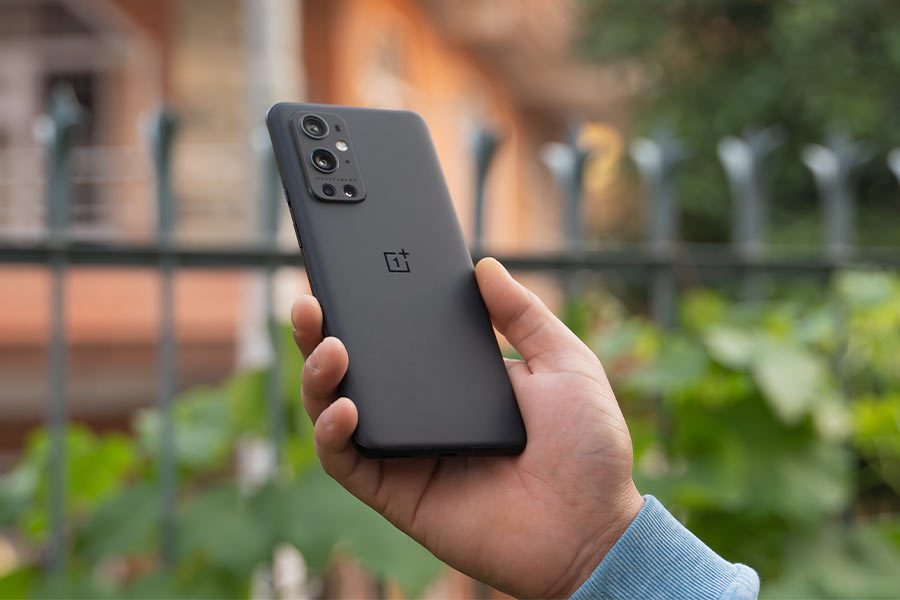
Still, I do wish there were some more refreshing color options to choose from. Apart from the Forest Green variant, the other 2 alternatives are pretty meh! The Stellar Black variant that I have with me does not attract smudges as the Morning Mist option does, but I think OnePlus could have taken some inspiration from S21 Ultra’s Phantom Black finish because that looks pretty dope!
Other than that, its design is nothing exceptional or outstanding. Except for the revamped camera layout and the missing OnePlus branding at the bottom, it’s basically the same as last year’s OnePlus 8 Pro.
Gorilla Glass... 5?
Weirdly, the company also didn’t include the latest Gorilla Glass Victus or even the Gorilla Glass 6 for that matter. Instead, OnePlus decided to go with almost 5 years old Gorilla Glass 5 on both the front as well as the back.
Review Images
1/2
Alert Slider
Regardless, there are also slight curves on the edges that add to the premium experience. Although the curvature of the edge this time around is less aggressive and the palm rejection is quite good, I’ve witnessed multiple instances of accidental touches which is ever so slightly bothersome. Additionally, I found it difficult to slide to the start of a YouTube video in portrait mode because of the curves.
Display
- 6.7 inches QHD+ Fluid AMOLED screen
- 120Hz refresh rate, 360Hz touch sampling rate
- 10-bit color depth, 1300 nits peak brightness
The display quality is what you would expect from a flagship phone of 2021 though. OnePlus 9 Pro uses the same panel as the Oppo Find X3 Pro. You get a gorgeous 6.7- inch QHD AMOLED display with all the bells and whistles like HDR10+ compliance, a 120Hz refresh rate, and LTPO backplane technology.
Here, this display can dynamically switch its refresh rate to as low as 1Hz, which is technically better than the 10Hz cap on the S21 Ultra. Likewise, throughout the review period, I didn’t face any issue with the brightness level on OnePlus 9 Pro either; be it outdoors on a sunny day or while using in bed at night. The auto-brightness sensor also works like a charm and the panel produces close to natural colors.
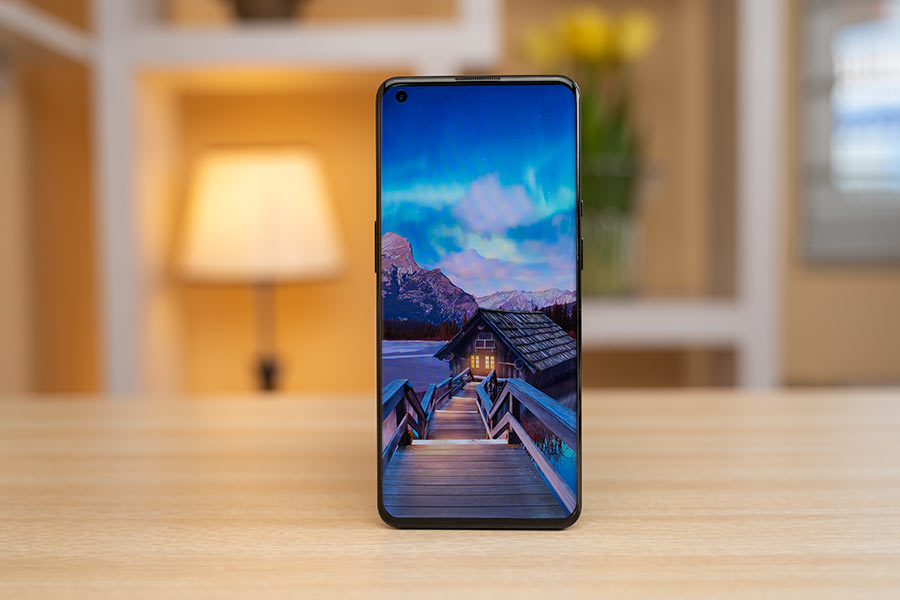
Plus, features like dark mode are well optimized as well. To save battery, the ambient display option is not always ON by default but you can toggle it as so, or even schedule when you’d want to turn on AoD. And with a new feature called Canvas, OnePlus even lets you use your photo as a background for the always ON display.
Not a perfect display
However, it’s by no means a perfect screen. For example, while streaming Netflix, videos look a bit darker here in comparison to the S21 Ultra. And before the latest update, while viewing certain HDR contents, the blacks were not pitch black but rather had a grayish shade. Thankfully, this particular issue has been resolved.
On the software side of things, OnePlus has tweaked OxygenOS 11 well to be comfortable to use with one hand, just like Samsung’s One UI. Plus, this Android skin has always been known for subtle yet useful customizations like the systemwide accent color or the easy use of an icon pack.
However, it would be great if OnePlus takes the inspiration from Samsung by guaranteeing 3 years of major OS upgrade as well. Likewise, OnePlus should have implemented the position of the fingerprint sensor a little higher like on the S21 Ultra. For someone like me with small hands, the relatively lowered placement took some time to get used to.
Fast in-display fingerprint sensor
Anyway, the sensor itself is wickedly fast and doesn’t miss a mark. But because of its optical heritage, you cannot use it when the display is turned OFF. On the contrary, this is possible with the S21 Ultra which comes with an ultrasonic sensor instead. So, you will require a bit of a trick on the OnePlus 9 Pro, which is turning ON the always-on Ambient display.
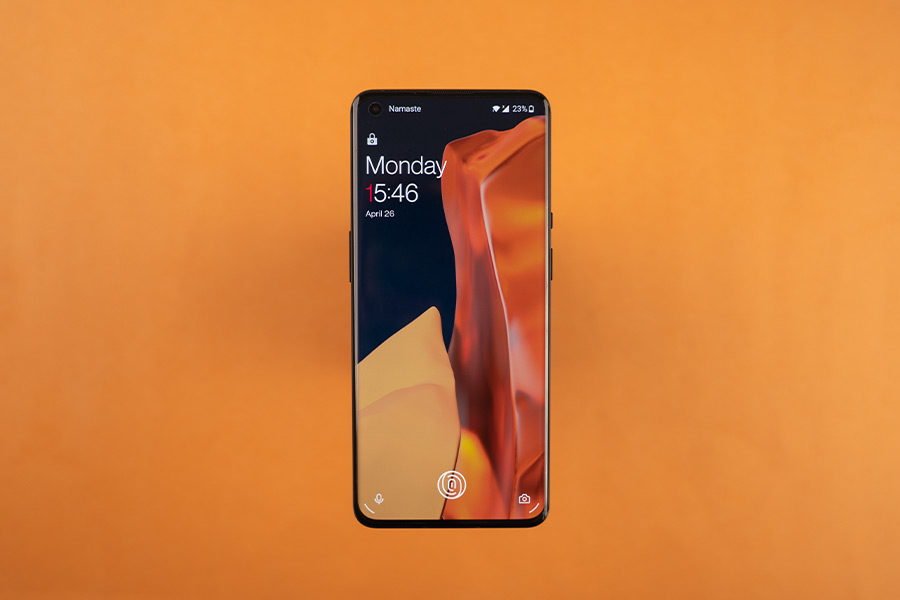
That being said, I have really liked how with every iteration, OnePlus is improving its haptic feedback as well as the speakers. If you remember, OnePlus used to be very far off with the likes of Samsung and iPhone in these aspects.
But now, these kinds of nitty-gritty details have been taken care of. After all, OnePlus is no longer a brand that makes flagship killer phones. And yeah, this one also has an IP68 rating, which reminds me of their 1124847803342049280 target="_blank" rel="noopener">tweet from back in 2019.
Performance
- Octa-core Qualcomm Snapdragon 888 5G SoC (5nm)
- 8/12GB LPDDR5 RAM, 128/256GB UFS 3.1 storage (fixed)
- Android 11 with OnePlus' OxygenOS 11 on top
Since the start of the OnePlus’s journey, the company has always used the latest and greatest Qualcomm chipset, so much so that I remember the time when the company went with the Snapdragon 810 on the OnePlus 2 despite wide publications of the chip’s massive overheating issues.
And this year’s no different for OnePlus either. Under the hood, you get Qualcomm’s latest Snapdragon 888 chipset, LPDDR5 RAM, and UFS 3.1 storage. Pair that with a 120Hz refresh rate and the ever so optimized OxygenOS, the phone feels fast, really fast! To compare, the Exynos 2100-powered S21 Ultra feels slightly slower than the 9 Pro.
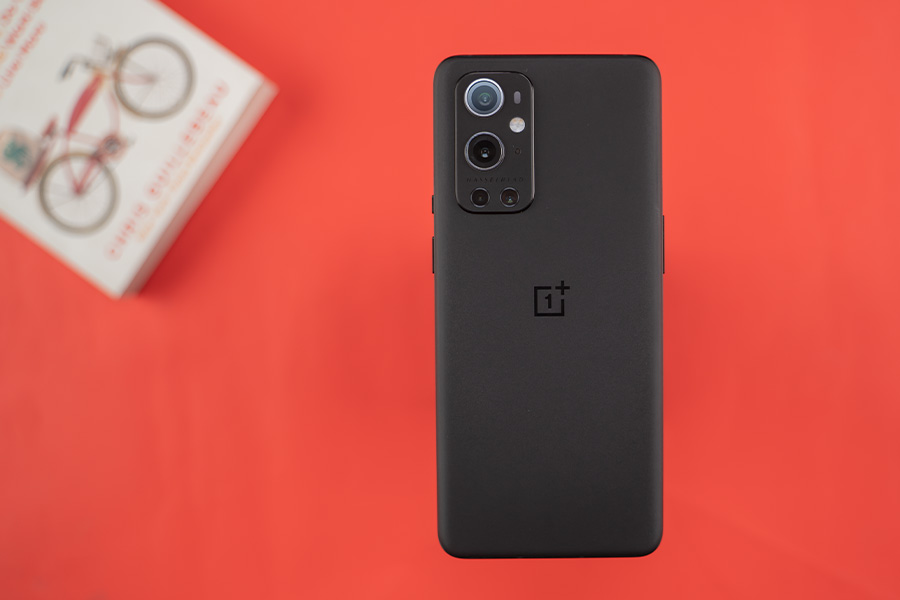
Keeping apps in memory has been piece of cake on the 12GB RAM variant that I have with me. So, from memory management to practically every aspect of performance, the phone works like a champ. And I’m pretty sure that will be the case even after say, 2 or 3 years down the road.
Heating issue
But, I've got to talk about the heating issue on this thing. Before the latest April update, even updating heavy apps or games, or using the phone while charging would make the phone heat up. Although the problem has been reduced by a lot after the few update, it still gets warm and that’s kind of frustrating.
For instance, playing graphic-intensive games like PUBG and Genshin Impact continuously for just half an hour takes the phone’s temperature to 42-degree C, which isn’t normal if you ask me.
Likewise, even when you’re shooting videos for a longer time, you will feel the phone getting warm mostly near the camera module. But especially while gaming for a long time, I’ve encountered multiple instances where the phone would become extremely uncomfortable to hold, because of which, I had to let it cool down for a bit.
Not cool, OnePlus
Ironically, OnePlus addressed this very same issue with other phones and bragged how the OnePlus 9 Pro’s “Cool Play” cooling system with 5 layers of copper graphite and other materials would keep the phone comparatively cooler than other flagship phones. Yet, the company has failed to keep its promise despite multiple updates.
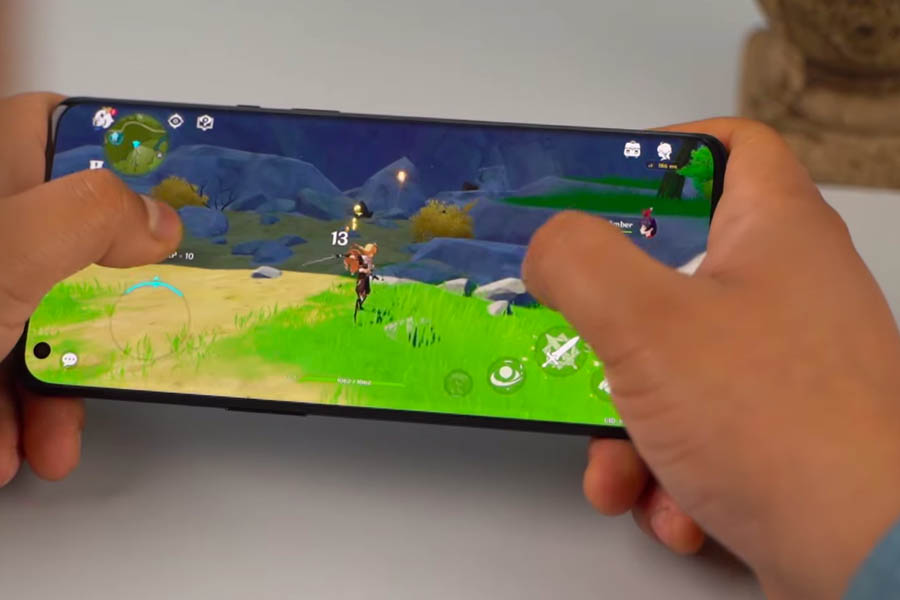
Don’t get me wrong. The gaming performance itself is quite good—even going beyond the default settings in games like PUBG can result in really stable and smooth gameplay. Demanding games like Genshin Impact can run on the OnePlus 9 Pro without a sweat in its default settings while I only noticed slight lags in the 60 fps mode throughout the review period.
Cameras
- Quad-camera setup at the back
- (48MP main, 50MP ultrawide, 8MP telephoto, 2MP B&W)
- Hasselblad Color Calibration on rear cameras
- 16MP selfie camera inside the punch-hole cutout
Review Images
1/2
Back
Given all the hype OnePlus had created about its partnership with popular camera company Hasselblad, everyone was super pumped up to see what the OnePlus 9 series had in store, me included. But soon after the reviews followed, it wasn’t what everyone expected.
And disclaimer, my verdict regarding the OnePlus 9 Pro’s cameras is the same. Its cameras are good. The primary 48MP lens with the new Sony IMX789 sensor, the telephoto lens, the ultra-wide sensor—all delivers top-notch performance. It’s just that OnePlus marketed its Hasselblad collaboration to seemingly yield an otherworldly camera experience, while that couldn’t be farther from the truth.
Normal Images
After clicking over 100s of photos from the OnePlus 9 Pro alongside the S21 Ultra for this review, I found that the primary and ultra-wide images from the OnePlus 9 Pro are slightly heavier in contrast.
Review Images
1/10
OnePlus 9 Pro
And although the Hasselblad partnership has mostly worked on fixing the color science or producing “natural color calibration” in the images, the photos tend to overdo the Red, Green, and Blue hues. Both cameras have a good focus, but I like how the S21 Ultra produces more true-to-life colors.
Wideangle Images
The color reproduction in ultra-wide mode is similar to the primary images too. I found both cameras doing a similar job except for the slightly higher contrast in OnePlus’ images.
Review Images
1/10
OnePlus 9 Pro
Also, its ultra-wide shots are a little distorted in the edges while S21 Ultra manages to maintain details in such areas better. This one especially comes as a surprise seeing how OnePlus promised the exact opposite result from its 50MP ultra-wide camera with a freeform lens.
Nighttime Images
And during low light and nighttime conditions, OnePlus tries to saturate the pictures a bit more in most cases. But the end result looks nice, so no complaints here. On the other hand, S21 Ultra has a very subtle & natural color reproduction both in normal and night mode shots.
Review Images
1/8
OnePlus 9 Pro - Nighttime
OnePlus’ images are slightly noisier than the S21 Ultra but it also reduces distortion in the edges better, hence retaining better sharpness in the corners.
Review Images
1/4
OnePlus 9 Pro - Wideangle Nighttime
Both phones let you shoot ultra-wide nighttime and night mode images and apart from the slightly boosted colors on the OnePlus 9 pro, they do quite a similar job actually!
Portrait Images
About the portraits, photos from the OnePlus 9 Pro portray a smoother and brightened subject. The background has a natural enough bokeh and edge detection is pretty good too. In fact, in some cases, edge detection is better here than the S21 Ultra.
Review Images
1/10
OnePlus 9 Pro
Even so, OnePlus has this really unnatural color tone in its portraits, which I thought would improve with an update but here I am.
Telephoto Images
OnePlus 9 Pro’s cameras are capable of optically zooming up to 3.3x via its telephoto camera and up to 30x digitally. The output is sharp but it tends to have a color shift from the primary images.
Review Images
1/4
Normal
But, note that it tries to maintain color details and sometimes outshines S21 Ultra like in this picture here.
Review Images
1/4
OnePlus 9 Pro - Normal
Review Images
1/6
1x
Given its flagship price tag, I also think OnePlus should have given an additional 10x periscope lens as the S21 Ultra.
Review Images
1/4
OnePlus 9 Pro - 10x Zoom
So, zooming further to 10x or 30x on the OnePlus 9 Pro isn’t going to give you good images.
Same ol' IMX471 upfront
While the company is using the latest sensors for its primary and ultra-wide lens with every iteration, for some weird reason, they are still using the same old IMX471 for the front-facing camera.
If you didn't know, this sensor made its official debut with the OnePlus 7 series and is even found on budget phones like the Realme 6.
The caveat with this sensor is you can only shoot selfie videos at 1080p 30 or 60 fps and nothing more. Although the quality is good and the videos are stable enough, I feel like, being a flagship phone, OnePlus should have gone with a newer lens that can shoot at higher resolutions, which the competitors like Samsung and iPhone have been providing for years.
Likewise, the Field of view on this thing isn’t great either. So, you’ll always need to stretch your arms a bit when you’re shooting videos. The audio from the microphone is quite good but still, for vlogging, it’s not the best option.
Selfie Images
As for the selfie photos, I found it shares similar color reproduction as the portraits where the S21 Ultra delivers relatively natural-looking images while OnePlus whitens and brightens the subject. OnePlus’ selfies are also softer while Samsung sharpens the pictures a bit more.
Review Images
1/8
OnePlus 9 Pro - Selfie
I had also conducted a 1387614763417407488 target="_blank" rel="noopener nofollow">blind camera test between the OnePlus 9 Pro and S21 Ultra on our Instagram page and well, the results were 63% against the 9 Pro and 37% for it.
Videography
Unlike the selfie video, the OnePlus 9 pro bears good videography prowess from the rear camera. You have the option to shoot at up to 8k 30 fps. The 8k videos are actually better stabilized here compared to the S21 Ultra so, good job there!
Impressively, the phone can shoot 8k 30fp videos even with its ultra-wide camera, but it does not let you switch in the same video. I hope that option comes out with an update. 4K 60 fps videos are nice and stable, thanks to OIS, and the video looks superb with great detail. Plus, you can shoot at 4k 120 fps too that you can edit in post to make really cool slo-mo videos.
Macro Images
Also, the macro images from the phone are quite good. Again, Samsung’s Focus Enhancer lets you go way closer and maintains good colors too. However, macro shots from the OnePlus 9 Pro are, as you can see, sharper and better.
Review Images
1/6
OnePlus 9 Pro
Hence, my conclusion on the OnePlus 9 Pro’s cameras is that they’re not bad as some of the reviews I have stumbled upon have painted it out to be. But, if you put it against the best camera phones out there, it will definitely lag behind, albeit by a small margin.
The things OnePlus needs to improve are mainly, the color, shadow processing, and consistency across lenses. With its 3 year partnership with Hasselblad, I hope the company will be able to achieve that eventually. Right now though, their collaboration is no doubt in the initial stage leaving a lot of room for improvement.
Battery
- 4500mAh battery, 65W wired charging
- 50W fast wireless charging
Like with the camera, the battery life on the OnePlus 9 Pro could see an improvement as well. With its 4500mAh cell, I was expecting similar endurance as last year’s OnePlus 8 Pro. In fact, it must have been doing better because of the aforementioned LTPO screen that can dynamically adjust the refresh rate up to 1Hz depending on the content on the screen.

This average battery life is maybe because of the slight heating issue, I don't know. But it most certainly hasn’t gotten better with the updates. Yet, what I like about OnePlus devices is they provide a 65W Power delivery charger inside the box; which isn’t just super fast to charge the phone, but it can charge my laptop too.
So, I don't need to carry both the laptop and the phone charger with me. Sweet! It also supports 50W wireless charging that juices up the device in under 45 mins, but I haven’t bought it yet.
Conclusion
So, to sum up this long-term review of the OnePlus 9 Pro, it is evident by now that the company made two critical mistakes when launching this phone. First, they hiked its price compared to its predecessor at a time when prices of other flagship phones are decreasing. And second is the pre-launch hype of the Hasselblad collaboration, which for me, was just too much.
Still, don't get any wrong idea, it's a very good phone. The thing is, after the launch of the OnePlus 8 and 8 Pro, it seems like they have exponentially shifted their focus in expanding the portfolio of the company—which is not at all a bad development. Yet, it’s just that in doing so, OnePlus has failed to live up to its own standard or build on it.
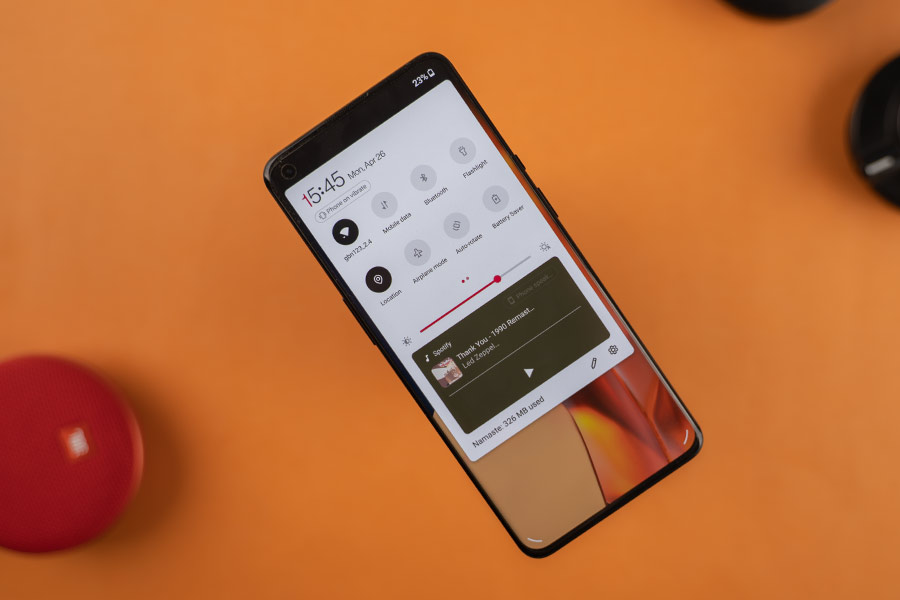
They launched the OnePlus Nord which was a great midrange phone, to begin with. But after that, they launched some Oppo rebranded phones, and jumped into the TV and accessories market (TWS, band, watch).
And when a company that used to launch just two flagship phones a year puts its foot in such a larger market by coming out with so many products in a bid to be a household name, it is bound for a bumpy ride. And that's pretty much reflected with the OnePlus 9 Pro’s pricing and how different issues like heating still haven't been taken care of after more than a month of the phone’s launch.
- Watch our video review of the OnePlus 9 Pro.
- Feels comfortable on the hand
- Vibrant 120Hz AMOLED screen
- Top-notch performance, as always
- Decent camera performance
- Fast 65W/50W wire/less charging
- No Gorilla Glass Victus protection
- Cameras don't live up to expectation
- Battery life is just about average

To say something about myself, I have been writing tech and gadgets from 2021. Although coming from a non technical studies background, I'm someone who is always fascinated by the latest gadget and tech innovations, circling around. Besides writing, you'll find me listening music and aligning the stars through astrology and sometimes even, tarot cards! 😉🧿
Comments
No comments yet. Add a comment to start a discussion

































































































































































